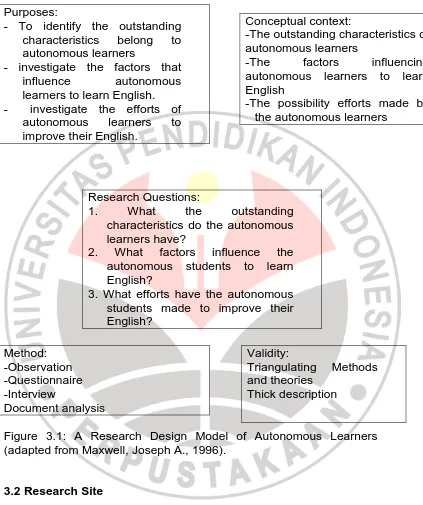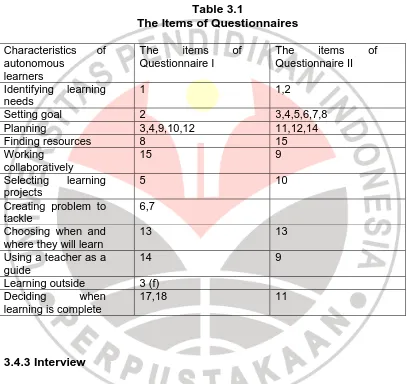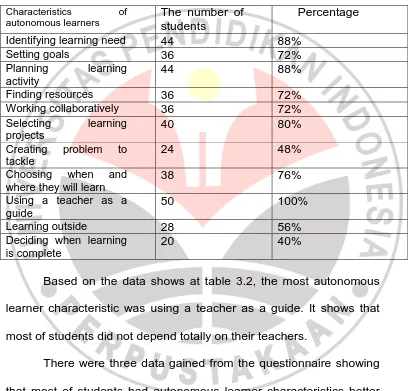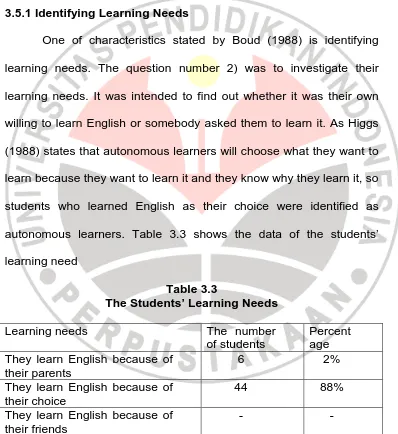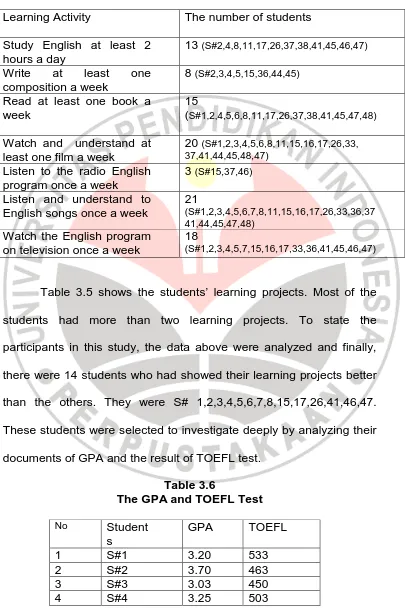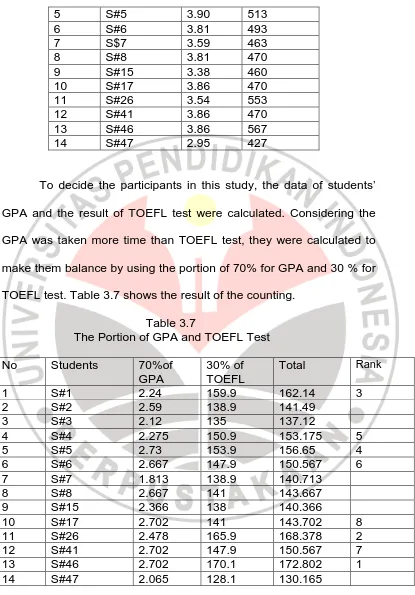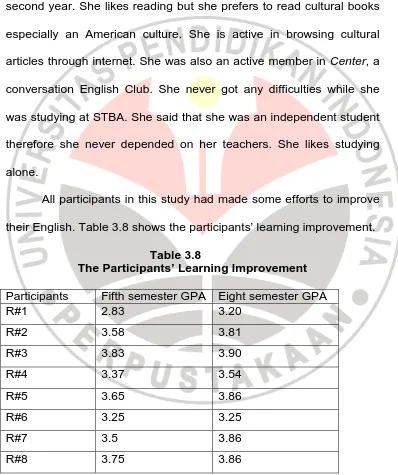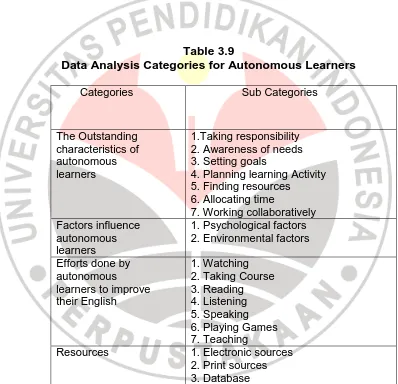CHAPTER III
METHODOLOGY
This chapter deals with the description and account of the
steps of what have been conducted in the study. The description
involves (1) research design, (2) research site, (3) research questions,
(4) data collection techniques, (5) participants in the study, (6) data
analysis, and (7) validity.
3.1 Research Design
One of the aims of teaching English is to make students
autonomous. Being autonomous learners, they have their own
characteristics, they are influenced by some factors, and they seem to
make some efforts to improve their English.
This study was aimed to identify the students as autonomous
learners, then to determine the outstanding characteristics of
autonomous learners. It was purposed also to investigate the factors
influencing autonomous learners and the efforts made by autonomous
learners to improve their English.
What mentioned above relates to their learning process as
Benson (2001) says that research to autonomous learners refers to
the learner’s broad approach to learning process, rather than to a
not a method of learning, but an attribute of learner’s approach to the
learning process.
This study investigates the autonomous learners. It uses a
qualitative method, which is appropriate in understanding process by
which events and actions take place (Maxwell, 1996:19).
In addition, this is a case study as it is an examination of a
specific phenomenon such as a process. Merriam (1988:16) says that
a qualitative case study is an intensive, holistic description and
analysis of a single instance, phenomenon, or social unit. Specifically,
she conceptualizes the case study as a process which tries to
describe and analyze some entities in qualitative, complex and
comprehensive terms not infrequently as it unfolds over a period of
time.
There were two steps in conducting this study. The first step
was intended to identify students as autonomous learners by doing
observation, distributing questionnaire, analyzing document, and
conducting interviews. The observation was conducted to investigate
students who were identified as good achievers. They would be
selected as autonomous learners or not, as what L. Dam and
Lagenhausen (1996) found in their research that autonomous learners
will be more effective and learn better than non-autonomous learners.
The data of achieved students were also gained from the interview
good achievers. Then, they were asked to fill in the questionnaire
consisted the items of autonomous learner characteristics based on
Boud’s theory. The answers of questionnaire were read and analyzed
to identify the students as autonomous learners or not.
The second step was determined to investigate the outstanding
characteristics of autonomous learners by using questionnaire and
interview. The interview was also conducted to investigate the factors
influencing autonomous learners and their efforts made by the
autonomous learners to improve their English.
To get the accurate result of this study, a research design,
which is called ‘interactive model’, offered by Maxwell, was adapted.
The model consists of five components; those are purposes,
conceptual context, research questions, methodology and validity.
(adapted from Maxwell, Joseph A., 1996).
3.2 Research Site
This research was conducted in STBA Yapari-ABA Bandung.
This college is one of educational foreign languages institutions which
one of the aims is to produce students who will be able to speak one Purposes:
- To identify the outstanding characteristics belong to autonomous learners
- investigate the factors that influence autonomous learners to learn English. - investigate the efforts of
autonomous learners to improve their English.
Conceptual context:
-The outstanding characteristics of autonomous learners
-The factors influencing autonomous learners to learn English
-The possibility efforts made by the autonomous learners
Research Questions:
1. What the outstanding characteristics do the autonomous learners have?
of foreign languages fluently. It has vision and mission to produce
students to become autonomous learners.
To gain the participants in this study, some of the English
students at fifth semester were involved in this study and they were
from different classes, from five classes of fifth semester of English
department.
3.3 Research Questions
Research questions for this study are:
3.3.1 What the outstanding characteristics do the autonomous
learners have?
3.3.2 What factors influence the autonomous learners to learn
English?
3.3.3. What efforts have the autonomous learners made to improve
their English?
3.4 Techniques of Collecting Data
In conducting this study, there are some techniques of
collecting data that have been used. Those are as follow.
3.4.1 Observation
Conducting qualitative research, observation is the best
can be observed first hand when a perspective is desire, or when
participants are not able or willing to discuss the topic under study
(Merriam, 1994:89).
Observation was conducted to select students who could be
identified as good achievers. It means they had achievement better
than others. Then, they were investigated to identify as autonomous
learners.
3.4.2 Questionnaire
In order to gain the written data which identify the students as
autonomous learners or not, the questionnaire was also administered.
For many good reasons the questionnaire is the most widely used
technique for obtaining information from the subject. It is relatively
economical, has the same questions for all subjects and can ensure
anonymity. Questionnaires can use statements or questions, but in all
cases the subject is responding to something written for specific
purposes (McMillan, 2001:257).
There were two kinds of questionnaire. The first one was about
the characteristics of autonomous learners taken from Boud’s theory.
It was distributed to 50 students who had been identified as good
achievers based on the data gained from observation and interview
The second questionnaire was open questionnaire and
there were 15 items. It was distributed to investigate some
outstanding characteristics that the autonomous learners have. Table
3.1 shows the items of questionnaire.
Table 3.1
Planning 3,4,9,10,12 11,12,14
Finding resources 8 15
This third technique used was the interviewing of selected
individuals who are considered as autonomous learners. Fraenkel and
Wallen (1993:385) state that interviewing is an important way for a
researcher to check the accuracy of−to verify or refute−the
impressions he or she has gained through observation. It is the most
says that interview can provide some additional information that was
missed in observation and can be used to check the accuracy of the
observations (Maxwell, 1996:76).
Interviews with the students who were considered as
autonomous learners were intended to gather data to answer
research questions. The interview which consisted open-ended
questions, were given to eight participants, and were recorded and
transcribed. In general, the interview items were the factors
influencing autonomous learners and their efforts to improve their
English.
3.4.4 Document Analysis
One of data collecting techniques is document analysis as
Merriam says that the researchers can use documentary material as
data (Merriam, 1988:1). She also adds that this technique is not much
different from using interviews or observation.
The documents used for this study were the records of GPA
(Grade Points Average) and the result of TOEFL test. These were
used as the last step to select students as the participants in this
3.5 The Participants in the Study
The participants in this study were English students of one of
the school of foreign languages in Bandung. Considering that there
were a lot of students, two kinds of selection were conducted to
decide students to be participants in this study. The first was to select
the students who were considered as good achievers. It means that
they had achieved their study better than others. This was done based
on the result of research conducted by L. Dam and L. Lagenhausen
(1996 cited in Benson, 2001). They say that autonomous learners will
more effective and learn better than non-autonomous learners. It was
conducted by observation and by interviewing to their teachers. The
second was to select students who were considered as autonomous
learners and would be the participants in this study. The questionnaire
was used to gain the data.
More than two hundred students of five classes were
observed. They were observed to know whether they had achieved
their learning well or not. The interview with their lecturer was also
conducted to get some information of the students ‘achievement. As
a result, there were fifty students considered as achieved students.
The first questionnaire was distributed to the fifty students.
The questionnaire was about the characteristics of autonomous
learners based on the theory of Boud (1988). The answers of the
could be categorized as autonomous learners. Table 3.2 shows the
results of the questionnaire.
Table 3.2
The results of the first questionnaire. Characteristics of
autonomous learners The number of students Percentage
Identifying learning need 44 88%
Setting goals 36 72%
Planning learning activity
44 88%
Finding resources 36 72%
Working collaboratively 36 72%
Selecting learning
Deciding when learning is complete
20 40%
Based on the data shows at table 3.2, the most autonomous
learner characteristic was using a teacher as a guide. It shows that
most of students did not depend totally on their teachers.
There were three data gained from the questionnaire showing
that most of students had autonomous learner characteristics better
than others, those were identifying learning needs (88%), planning
learning activity (88%), and selecting learning projects (80%). To
select and investigate students as participants in this study, these
says that while it is difficult to judge whether learners have become
autonomous or not, it is possible to judge whether they are able to
produce more effective learning plans, participating more decision
making processes, and reflect more deeply on their learning.
3.5.1 Identifying Learning Needs
One of characteristics stated by Boud (1988) is identifying
learning needs. The question number 2) was to investigate their
learning needs. It was intended to find out whether it was their own
willing to learn English or somebody asked them to learn it. As Higgs
(1988) states that autonomous learners will choose what they want to
learn because they want to learn it and they know why they learn it, so
students who learned English as their choice were identified as
autonomous learners. Table 3.3 shows the data of the students’
learning need
Table 3.3
The Students’ Learning Needs
Learning needs The number
autonomous learners because it was their choice to learn English. The
2 % of students (six students) were not considered as autonomous
learners because they did not know what they wanted to learn. They
learned English because their parents asked them to. The six
students were S#10, 12, 28, 29, 30, and 49 and they were not taken
also to be further selected as the participants in this study.
3.5.2 Planning Learning Activities
The autonomous learners will state their planning learning
activities (Boud, 1988). The question numbers 6 of the questionnaire
was aimed to investigate how many learning activities which the
students had planned.
Table 3.4
The Students; Planning Learning Activities Leaning activity The number of students
Going to the library to
Reading some English books
English subjects with
17
friends 45,47,46) Taking an English
course
14
(S#1,4,7,11,14,15,16,18,23,26,33,38,45,4 6)
Participating
conversation club actively
10
(S#2,3,4,8,11,15,16,17,26,45)
Table 3.4 shows the planning learning activities had been done
by the students. Most of the students had more than one activity.
According to Benson (2001), the autonomous learners are responsible
for their own learning, they routinely initiate and manage their own
learning both outside and within the context of formal learning.
Therefore students who had many learning activities more than others
were taken to be the participants in this study.
Based on the data above, there are 23 students who had
planned many learning activities. This shows that they were more
active than the others. To gain the participants of this study, these
students were investigated deeply.
3.5.3 Selecting Learning Projects
One of autonomous learner characteristics stated by Boud
(1988) is selecting learning projects. The question number 8 of the
questionnaire was aimed to investigate the autonomous learning
projects. There were seven learning projects suggested to be chosen
Table 3.5
The students’ Learning Projects Learning Activity The number of students
Study English at least 2 English songs once a week
21
(S#1,2,3,4,5,6,7,8,11,15,16,17,26,33,36,37 41,44,45,47,48)
Watch the English program on television once a week
18
(S#1,2,3,4,5,7,15,16,17,33,36,41,45,46,47)
Table 3.5 shows the students’ learning projects. Most of the
students had more than two learning projects. To state the
participants in this study, the data above were analyzed and finally,
there were 14 students who had showed their learning projects better
than the others. They were S# 1,2,3,4,5,6,7,8,15,17,26,41,46,47.
These students were selected to investigate deeply by analyzing their
documents of GPA and the result of TOEFL test.
Table 3.6
5 S#5 3.90 513
make them balance by using the portion of 70% for GPA and 30 % for
TOEFL test. Table 3.7 shows the result of the counting.
Table 3.7
The Portion of GPA and TOEFL Test
The data above shows that S# 46, 26, 1, 5, 4, 6, 41, 17 are the
eight best students so these eight students were taken as the
participants in this study.
These participants were coded as R#1 (S#1), R#2 (S#6), R#3
(S#5), R#4 (S#26), R#5 (S#41), R#6 (S#4), R#7 (S#46), and R#8
(S#17). It is done in order to keep the participants’ privacy, so their
real names are not mentioned here. The profiles of them are as
following.
R#1 was 24 years old. She is Javanese. She likes English since
she was an elementary school student at second year although at that
time she has not got an English subject at her school. She likes
English because her grand mother was an English teacher therefore
she was always motivated by her grand mother. At first, she listened
to English songs (Beatles’s songs). She tried to understand the songs
and tried to sing them to make her pronunciation better. Then, she is
used to watching film and whenever she watched it she never read
the Indonesian sub-title. She tried to understand by herself. If she
found some difficult vocabulary, she opened the dictionary. She used
to do it so she has got a lot of English vocabulary when she studied
English at SMP, and she never opened the dictionary again if she had
to translate English texts. Her grand mother always taught her English
since she was an elementary school. If she got any difficulties in
English, she is used to doing some efforts, those are filling crossword
to enlarge her vocabulary, doing scrabble, watching English films, and
listening English songs.
R#2 was 23 years old. He has finished his diploma (D3) in 2005
and directly continued his study to take S1 in the same year. He
finished his study in 2006. He likes English since he was an
elementary school student at second year. He likes it because he saw
his friends like English songs and he tried to listen to. It made him
interested in listening English songs then he tried to understand the
songs by translating them into Indonesia by his own. In translating the
songs he used to open the dictionary. He likes reading very much. He
has a reading habit. He used to read Newsweek and Times on
Wednesdays. He is also used to reading English novels on Fridays.
R#3 was 22 years old. She finished her study at STBA in 2006
with the highest grade point average (IPK) that is 3.90. She likes
English very much. She started to learn English when she was an
elementary school student, at third year although she has not got an
English subject at her school at that time. She likes watching film very
much. She is used to watching films and she tried to understand it by
translating it. She bought an English dictionary by herself when she
was 9 years old. She has taken an English course for one year. It was
only formality to make sure her English good or not. She has a good
English book everyday. She used to read Reader Digest and Jakarta
Post. She likes studying alone because she did not believe her
friends, she said. Right now she is trying to get scholarship to study
abroad.
R#4 was 26 years old. At first, she took diploma program (D3) at
STBA and finished it in 2004. Then she worked, she taught English at
an English course (AIL). In 2005, she continued her study to take S1
program at STBA. She finished it for one year, in 2006. She likes
English since she was an elementary school student at fourth year
although she did not get an English subject at her elementary school.
She started to learn English from her brother’s English book. She tried
to read it and tried to do the exercises of the book. She did it alone;
she did not ask her brother or anyone else. She always watches films,
listens English songs, reads an English novel. To improve her English,
she is used to speaking English everyday. She has some best friends
who always make communication with her in English. They are
English teachers too. So, whenever she has got any problems with
her English, she discusses with her friends.
R#5 was 22 years old. He likes English very much. He likes
watching film, listening to English song especially Celine Dion’s
songs. He wanted to understand any English songs he listened
therefore he asked her brother to teach him English. His brother
He also always asked her brother to translate the English songs into
Indonesian. Then, he tried to memorize any new vocabulary he found.
When he was studying at STBA, he tried hard to improve his English.
He spoke English with his best friends and if they spoke Bahasa
Indonesia they had to pay two candies for one Indonesian word. He
did it everyday. He took part actively in ASES and he was a member
of Center. It is an English conversation club.
R#6 was 24 years old. She likes English very much. She liked it
for the first time when she was an elementary student. She learnt
English from her parents, her brothers, and her relatives in abroad.
She learnt English also from films especially series films (Mc Gryver
and Beverly Hill). She has ever taken an English course for six
months at EF. She improved her English by making communication
through internet with her relatives in abroad or with her father’s guests
from abroad who stay a night at her father’s inn.
R#7 was 23 years old. She finished her study in 2006. She likes
watching TV and films very much especially series films (Beverly Hill).
She used to watch film with her family. Whenever she watched films
she tried hard to understand it without reading the Indonesian
sub-title. She said she liked English for the first time when she was a
kindergarten student. When she was at the elementary school she
R#8 was 23 years old. She likes English for the first time when
she studied it for the first time (when she was an SMP student). She
took an English course for four years. Then she taught English for the
first time at her English course when she was an SMA student, at
second year. She likes reading but she prefers to read cultural books
especially an American culture. She is active in browsing cultural
articles through internet. She was also an active member in Center, a
conversation English Club. She never got any difficulties while she
was studying at STBA. She said that she was an independent student
therefore she never depended on her teachers. She likes studying
alone.
All participants in this study had made some efforts to improve
their English. Table 3.8 shows the participants’ learning improvement.
Table 3.8
The Participants’ Learning Improvement Participants Fifth semester GPA Eight semester GPA
R#1 2.83 3.20
R#2 3.58 3.81
R#3 3.83 3.90
R#4 3.37 3.54
R#5 3.65 3.86
R#6 3.25 3.25
R#7 3.5 3.86
3.6 Data Analysis
The steps in the analysis included the following.
3.6.1 The raw field notes from research’s observation were re-written
and read.
3.6.2 The data obtained from the interview with teachers were
analyzed.
3.6.3 The data obtained from the first questionnaire was calculated.
The first step was analyzing the students’ learning need. The
second was analyzing the students’ planning learning activities.
To analyze students’ selecting learning projects was the third
step.
3.6.4 The data obtained from the students’ learning documents, GPA
and TOEFL test was calculated.
3.6.5 To conduct the interview to autonomous learners
3.6.6 The data obtained from the interview were transcribed.
3.6.7 The data obtained from the interview was then identified into
some tentative ideas of outstanding characteristics
autonomous learners and the factors influencing autonomous
learners and the efforts made by them to improve their English.
3.6.8 The next step was making use of coding. Strauss (1987 cited in
Maxwell, 1996: 78) describes it that in qualitative research, the
goal of coding is not to produce counts, but to “fracture” the
comparison of the data within and between these categories
and that aid in the development of theoretical concepts.
3.6.9 The last step was taking out the conclusion about the study.
Table 3.7 summarizes data analysis categories for autonomous
learners.
Table 3.9
Data Analysis Categories for Autonomous Learners
Categories Sub Categories
Resources 1. Electronic sources
2. Print sources 3. Database
3.7 Validity
Creswell (1994) states the qualitative researchers have no
single stance consensus on addressing traditional topics such as
says that qualitative researchers are able to use many strategies as
possible to enhance validity. Therefore a number of techniques are
used to ensure the validity, those are:
3.7.1 Triangulation
Triangulation is using multiple methods of gathering data and
multiple sources of data to confirm the emerging findings (Merriam,
1988:169). To ensure the validity of this research, data sources: field
notes and transcripts, were triangulated. Four techniques of collecting
data were also applied: observation, document analysis, interview,
and questionnaire. Those were used to identify the outstanding
characteristics of autonomous learners, the factors influencing them,
and the efforts made by the autonomous learners to improve their
English.
The data obtained from observation were analyzed and
triangulated with the data gained from interview with teachers. Then,
the data obtained from the questionnaire were analyzed and
calculated to identify students as autonomous learners, based on the
characteristics of autonomous learners from Boud (1988). Analyzing
and calculated are also applied for the data obtained from the
3.7.2 Thick Description
In an effort to build the reliability of the data, this study is
described in detail in a rich description as the end product of the
study, so that the findings of the study can be applied to other
situations (Meriam, 1988:177). Analyzing, presenting, discussing the
data as complete as possible were done to provide a detailed
CHAPTER V
CONCLUSIONS AND SUGGESTIONS
This chapter consists of two sections. First, the conclusions of
the research conducted based on the research questions as
mentioned and explained in chapter 1. Second, the suggestions
addressed to the researchers who are interested in conducted further
research on autonomous learners.
5.1 Conclusions
In relation to three major research questions which are stated
earlier in chapter I, namely the characteristics of autonomous
learners, the factors influence the autonomous learners to learn
English, and the efforts done by the autonomous learners, there are
four conclusions can be presented.
First, autonomous learners are self-managed learners. They
take responsibility for their learning. They are aware of their learning
needs. They also set their learning goals. They plan their learning
activities and find any learning materials. They allocate time for their
learning.
Second, autonomous learners are not isolated learners. They
They need teachers as their counselor who can support them to
become autonomous.
Third, autonomous learners will be influenced by positive
exposures which are favorable to assist them to become autonomous.
These exposures can be authentic sounds, films, authentic printed
materials, and internet.
Fourth, autonomous learners set their priority of their learning
needs. They plan their learning activities. These efforts are made to
improve their learning. Some of the efforts are individual activities
made by learners individually.
5.2 Suggestions
From the conclusion above, some suggestions as efforts to
promote students to become autonomous learners are specifically put
forward to teachers and other researchers.
As it has been stated that autonomy is one of educational
goals, this situation can create learners to become autonomous. It
means that they have responsibility for their own learning; therefore it
is advisable for teachers to assist and to motivate their learners to
become autonomous.
In helping learners to be autonomous, it is better for teacher to
pay attention to their characteristics. It can help them to determine
It is advisable for teacher to know what factors influencing their
learners to be autonomous. This can assist them to be more
autonomous.
It is better for teachers to develop the facility, where students
have access to computers, cassettes (for listening and recording),
library materials, language games, testing materials, etc. This can
help, motivate, and support learners to become more autonomous
beside that, they can improve their English.
For the other researchers, the result of the study can be used
BIBLIOGRAPHY
Aoki, Naoko. 1999. Affect and the Role of Teachers in the
Development of Learner Autonomy in Affect in Language Learning ed by Jane Arnold. Cambridge: Cambridge
University.
Angela, Mok. 1997. Student Empowerment in an Language
Enrichment Programme: an action research project in Hong Kong. Hong Kong: The Hong Kong Institute of Education.
Benson, Phil. 2001. Teaching and Researching Autonomy in
Language Learning. Essex: Pearson Education.
Boud, David. 1988. Developing Student Autonomy in Learning. Second Edition New York: Nichols Publishing Company.
Brigthman,Harvey J. 2001 GSU Master Teacher Program: On
Critical Thinking (an article). Georgia State Uninersity.
Brookes, Arthur and Peter Grundy. 1988. Individualization and
Autonomy in Language Learning. Hong Kong: Modern
English
Brown, H. Douglas. 1994. Teaching by Principles, An Interactive
Approach to Language Pedagogy. New York: Prentice Hall
Regents
Candy, Philip. 1988. On the Attachment of Subject-Matter
Autonomy. In Boud. p: 59-76. New York: Nichols Publishing
Company.
Creswell, John W. 1994. Research Design, Qualitative &
Quantitative Approaches. London: Sage Publications.
Cross, K. Patricia. 1981. Adults as Learners. San Francisco: Jossey-Bass
Dickinson, Leslie. 1988. Learner Training in Individualization and
Autonomy in Language Learning ed by Arthur Brookes and
Peter Grundy. Hong Kong: Modern English Publications
Exley, Beryl. 2005. Learner Characteristics of Asian EFL Students; Exception to Norm’ Queensland. (an article).
Geddes, Marion & Gill Strutridge. !997. Individualization.
Fraenkel. Jack R., and Norman E. Wallen. 1993. How to Design
and Evaluate Research in Education. New York:
Mcgraw-Hill.
Hamied, Fuad A. 2003. National Education System, Regional
Autonomy and TEFL in Indonesia. A paper presented at the
First Asia TEFL international Conference, 7-9 November 2003.
Higgs, Joy. 1988. Planning Learning Experiences to Promote
Autonomous Learning in Boud p 40-58. New York: Nichols
Publishing Company.
Kismadi, Gloria C. 2002. Paving the Way for Autonomous Learning
Are We Ready for It? A paper presented at ITB Fourth
National Conference, 12-14 March 2002
Knapper, Christopher. 1981. Technology and Lifelong Learning. in Boud p 91-105. New York: Nichols Publishing Company.
Lengkanawati, Nenden. 2005. EFL Teachers’ Competence in the
Context of English Curriculum 2004: Implication for EFL teacher Education. (an article). TEFLIN Journal.
Little, David and Leni Dam. 1998. Learner Autonomy, What and
Musthafa, Bachrudin. 1997. Content Area Reading: Principles and
Nunan, David. 1988. The Learner-Centred Curriculum a Study in
Second Language Teaching. Cambridge.
Oxford, Rebecca L. 1990. Language Learning Strategies: What Every Teacher Should Know. Boston: Heinle & Heinle
Richard-Amato, Patricia A. 2003. Making It Happen. New York: Longman
Richards, Jack C..1998. Beyond Training. Cambridge: Cambridge University Press.
Toyoda, Etsuko.2001. Exercise of Learner Autonomy in
Project-Oriented CALL. Australia (an article).
Wenden, Anita. 1991. Learner Strategies for Learner Autonomy. Cambridge: Prentice Hall.
Yuen Pan, Daphne. 1997. Lifelong Learning: The Whole DAMN
Cycle- A Singapore Perspective in Lifelong Learning, ed by
